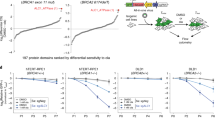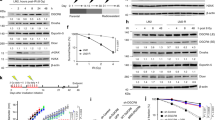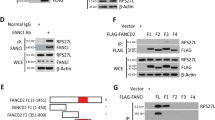Abstract
HIGD1A is an important mitochondrial protein recently shown to have a novel nuclear localization under severe stress. However, whether this protein is also associated with the DNA damage response has rarely been studied. Here, we reported that DSBs-induced the translocation of mitochondrial HIGD1A to the nucleus is dependent on nuclear pore complex (NPCs), which finally promotes HR and radio/chemo-resistance. Importantly, NUP93 and HIGD1A physically interact and the interaction domain with NUP93 is located at residues 46–60 of HIGD1A. Chromatin-enriched HIGD1A can then directly interact with RPA. During the early stages of HR, HIGD1A promotes the loading of RPA to DSBs and activates the DNA damage-dependent chromatin association of RAD9-RAD1-HUS1 complex (9-1-1), which stimulates the ATR-Chk1-dependent G2/M DNA damage checkpoint. After facilitating RPA-ssDNA binding, HIGD1A in turn inhibits abnormal persistence of RPA1 foci by promoting ubiquitination of RPA1 and inducing its eventual proteasomal degradation. In addition, we have identified clinical drug Preveon associated with the HIGD1A-NUP93 interaction domain using a virtual screening approach. This compound directly interacted with HIGD1A, which was verified by NMR, and then inhibited HIGD1A translocation. Collectively, we demonstrate a novel role for HIGD1A in DSBs and provide rationale for using HIGD1A inhibitors as cancer therapeutics.
This is a preview of subscription content, access via your institution
Access options
Subscribe to this journal
Receive 50 print issues and online access
$259.00 per year
only $5.18 per issue
Buy this article
- Purchase on Springer Link
- Instant access to full article PDF
Prices may be subject to local taxes which are calculated during checkout










Similar content being viewed by others
References
Jackson SP, Bartek J. The DNA-damage response in human biology and disease. Nature. 2009;461:1071–8.
O’Connor MJ. Targeting the DNA damage response in cancer. Mol Cell. 2015;60:547–60.
Shaughnessy DT, McAllister K, Worth L, Haugen AC, Meyer JN, Domann FE, et al. Mitochondria, energetics, epigenetics, and cellular responses to stress. Environ Health Perspect. 2014;122:1271–8.
Xu LM, Wu TT, Lu SH, Hao XH, Qin JC, Wang J et al. Mitochondrial superoxide contributes to oxidative stress exacerbated by DNA damage response in RAD51-depleted ovarian cancer cells. Redox Biol. 2020;36:101604.
Pantano C, Reynaert NL, van der Vliet A, Janssen-Heininger YMW. Redox-sensitive kinases of the nuclear factor-B-K signaling pathway. Antioxid Redox Signal. 2006;8:1791–806.
Lans H, Marteijn JA, Vermeulen W. ATP-dependent chromatin remodeling in the DNA-damage response. Epigenetics Chromatin 2012;5:4.
Tang JB, Goellner EM, Wang XH, Trivedi RN, St Croix CM, Jelezcova E, et al. Bioenergetic metabolites regulate base excision repair-dependent cell death in response to DNA damage. Mol Cancer Res. 2010;8:67–79.
Ying W. Roles of NAD (+), PARP-1, and Sirtuins in cell death, ischemic brain injury, and synchrotron radiation X-Ray-induced tissue injury. Science. 2013;2013:691251.
Qian W, Choi S, Gibson GA, Watkins SC, Bakkenist CJ, Van Houten B. Mitochondrial hyperfusion induced by loss of the fission protein Drp1 causes ATM-dependent G2/M arrest and aneuploidy through DNA replication stress. J Cell Sci. 2012;125:5745–57.
Kosova AA, Khodyreva SN, Lavrik OI. Role of glyceraldehyde-3-phosphate dehydrogenase (GAPDH) in DNA repair. Biochem-Mosc. 2017;82:643–54.
Ci SS, Xia W, Liang WC, Qin LH, Zhang YL, Dianov GL, et al. Src-mediated phosphorylation of GAPDH regulates its nuclear localization and cellular response to DNA damage. Faseb J. 2020;34:10443–61.
An HJ, Cho G, Lee JO, Paik SG, Kim YS, Lee H. Higd-1a interacts with Opa1 and is required for the morphological and functional integrity of mitochondria. P Natl Acad Sci USA. 2013;110:13014–9.
Ameri K, Jahangiri A, Rajah AM, Tormos KV, Nagarajan R, Pekmezci M, et al. HIGD1A regulates oxygen consumption, ROS production, and AMPK activity during glucose deprivation to modulate cell survival and tumor growth. Cell Rep. 2015;10:891–9.
Hayashi H, Nakagami H, Takeichi M, Shimamura M, Koibuchi N, Oiki E, et al. HIG1, a novel regulator of mitochondrial gamma-secretase, maintains normal mitochondrial function. Faseb J. 2012;26:2306–17.
Li T, Xian WJ, Gao Y, Jiang S, Yu QH, Zheng QC, et al. Higd1a protects cells from lipotoxicity under high-fat exposure. Oxidative Med Cell Longev. 2019;2019:6051262.
Hayashi T, Asano Y, Shintani Y, Aoyama H, Kioka H, Tsukamoto O, et al. Higd1a is a positive regulator of cytochrome c oxidase. P Natl Acad Sci USA. 2015;112:1553–8.
Ameri K, Rajah AM, Nguyen V, Sanders TA, Jahangiri A, DeLay M, et al. Nuclear localization of the mitochondrial factor higd1a during metabolic stress. Plos One 2013;8:e62758.
Mohr D, Frey S, Fischer T, Guttler T, Gorlich D. Characterisation of the passive permeability barrier of nuclear pore complexes. Embo J. 2009;28:2541–53.
Wassing IE, Esashi F. RAD51: Beyond the break. Semin Cell Dev Biol. 2021;113:38–46.
Parrilla-Castellar ER, Arlander SJ, Karnitz L. Dial 9-1-1 for DNA damage: the Rad9-Hus1-Rad1 (9-1-1) clamp complex. DNA Repair (Amst). 2004;3:1009–14.
Damasceno JD, Obonaga R, Santos EV, Scott A, McCulloch R, Tosi LRO. Functional compartmentalization of Rad9 and Hus1 reveals diverse assembly of the 9-1-1 complex components during the DNA damage response in Leishmania. Mol Microbiol. 2016;101:1054–68.
Zabludoff SD, Deng C, Grondine MR, Sheehy AM, Ashwell S, Caleb BL, et al. AZD7762, a novel checkpoint kinase inhibitor, drives checkpoint abrogation and potentiates DNA-targeted therapies. Mol Cancer Ther. 2008;7:2955–66.
Basu A, Krishnamurthy S Cellular responses to Cisplatin-induced DNA damage. J Nucleic Acids. 2010;2010.
Wozniak AJ, Glisson BS, Hande KR, Ross WE. Inhibition of etoposide-induced DNA damage and cytotoxicity in L1210 cells by dehydrogenase inhibitors and other agents. Cancer Res. 1984;44:626–32.
Klammt C, Maslennikov I, Bayrhuber M, Eichmann C, Vajpai N, Chiu EJC, et al. Facile backbone structure determination of human membrane proteins by NMR spectroscopy. Nat Methods. 2012;9:834–+.
Liu C, He G, Jiang QL, Han B, Peng C. Novel hybrid virtual screening protocol based on molecular docking and structure-based pharmacophore for discovery of Methionyl-tRNA synthetase inhibitors as antibacterial agents. Int J Mol Sci. 2013;14:14225–39.
Chou TC. Drug combination studies and their synergy quantification using the Chou–Talalay method. Cancer Res. 2010;70:440–6.
Nagao T, Shintani Y, Hayashi T, Kioka H, Kato H, Nishida Y, et al. Higd1a improves respiratory function in the models of mitochondrial disorder. Faseb J. 2020;34:1859–71.
Cheng ZH, Wang GY, Zhu WY, Luo C, Guo ZL. LEF1-AS1 accelerates tumorigenesis in glioma by sponging miR-489-3p to enhance HIGD1A. Cell Death Dis. 2020;11:690.
Timon-Gomez A, Garlich J, Stuart RA, Ugalde C, Barrientos A. Distinct Roles of Mitochondrial HIGD1A and HIGD2A in Respiratory Complex and Supercomplex Biogenesis. Cell Rep. 2020;31:107607.
Chuderland D, Konson A, Seger R. Identification and characterization of a general nuclear translocation signal in signaling proteins. Mol Cell. 2008;31:850–61.
Hsu DW, Kiely R, Couto CAM, Wang HY, Hudson JJR, Borer C, et al. DNA double-strand break repair pathway choice in Dictyostelium. J Cell Sci. 2011;124:1655–63.
Brandsma I, Gent DC. Pathway choice in DNA double strand break repair: observations of a balancing act. Genome Integr. 2012;3:9.
Dudas A, Chovanec M. DNA double-strand break repair by homologous recombination. Mutat Res-Rev Mutat. 2004;566:131–67.
Pokhrel N, Origanti S, Davenport EP, Gandhi D, Kaniecki K, Mehl RA, et al. Monitoring Replication Protein A (RPA) dynamics in homologous recombination through site-specific incorporation of non-canonical amino acids. Nucleic Acids Res. 2017;45:9413–26.
Zou Y, Liu YY, Wu XM, Shell SM. Functions of human replication protein A (RPA): From DNA replication to DNA damage and stress responses. J Cell Physiol. 2006;208:267–73.
Nuss JE, Patrick SM, Oakley GG, Alter GM, Robison JG, Dixon K, et al. DNA damage induced hyperphosphorylation of replication protein A. 1. Identification of novel sites of phosphorylation in response to DNA damage. Biochemistry. 2005;44:8428–37.
Ma CJ, Gibb B, Kwon Y, Sung P, Greene EC. Protein dynamics of human RPA and RAD51 on ssDNA during assembly and disassembly of the RAD51 filament. Nucleic Acids Res. 2017;45:749–61.
Dueva R, Iliakis G. Replication protein A: a multifunctional protein with roles in DNA replication, repair and beyond. NAR Cancer. 2020;2:zcaa022.
Yang Q, Zhu Q, Lu X, Du Y, Cao L, Shen C, et al. G9a coordinates with the RPA complex to promote DNA damage repair and cell survival. Proc Natl Acad Sci USA. 2017;114:E6054–E6063.
Inano S, Sato K, Katsuki Y, Kobayashi W, Tanaka H, Nakajima K, et al. RFWD3-mediated ubiquitination promotes timely removal of both RPA and RAD51 from DNA damage sites to facilitate homologous recombination. Mol Cell. 2017;66:622–34. e628
Zou L, Elledge SJ. Sensing DNA damage through ATRIP recognition of RPA-ssDNA complexes. Science. 2003;300:1542–8.
Raynard S, Niu HY, Sung P. DNA double-strand break processing: the beginning of the end. Gene Dev. 2008;22:2903–7.
Saldivar JC, Cortez D, Cimprich KA. The essential kinase ATR: ensuring faithful duplication of a challenging genome. Nat Rev Mol Cell Bio. 2017;18:783–783.
Sorensen CS, Hansen LT, Dziegielewski J, Syljuasen RG, Lundin C, Bartek J, et al. The cell-cycle checkpoint kinase Chk1 is required for mammalian homologous recombination repair. Nat Cell Biol. 2005;7:195–U121.
Acknowledgements
This work was supported by the National Science Fund for Excellent Young Scholars (12122510), the National Natural Science Foundation of China (32171240, 11835014, and 31870845), the HFIPS Director’s Fund (Grant No. YZJJZX202014) and the CAS Pioneer Hundred Talents Program (GZ).
Author information
Authors and Affiliations
Contributions
GZ and BC conceived of the study; BC, FX, YG, GH, KZ, and HL conducted experiments; SC, AX and LW analyzed and interpreted the data; GZ and BC wrote the manuscript. All authors read and approved the final manuscript.
Corresponding author
Ethics declarations
Competing interests
The authors declare no competing interests.
Additional information
Publisher’s note Springer Nature remains neutral with regard to jurisdictional claims in published maps and institutional affiliations.
Rights and permissions
About this article
Cite this article
Chen, B., Xu, F., Gao, Y. et al. DNA damage-induced translocation of mitochondrial factor HIGD1A into the nucleus regulates homologous recombination and radio/chemo-sensitivity. Oncogene 41, 1918–1930 (2022). https://doi.org/10.1038/s41388-022-02226-9
Received:
Revised:
Accepted:
Published:
Issue Date:
DOI: https://doi.org/10.1038/s41388-022-02226-9
This article is cited by
-
Elevated expression of HIGD1A drives hepatocellular carcinoma progression by regulating polyamine metabolism through c-Myc–ODC1 nexus
Cancer & Metabolism (2024)
-
Enhancer-driven transcription of MCM8 by E2F4 promotes ATR pathway activation and glioma stem cell characteristics
Hereditas (2023)
-
Protein disulfide isomerase blocks the interaction of LC3II-PHB2 and promotes mTOR signaling to regulate autophagy and radio/chemo-sensitivity
Cell Death & Disease (2022)
-
Role of mitochondria in nuclear DNA damage response
Genome Instability & Disease (2022)



